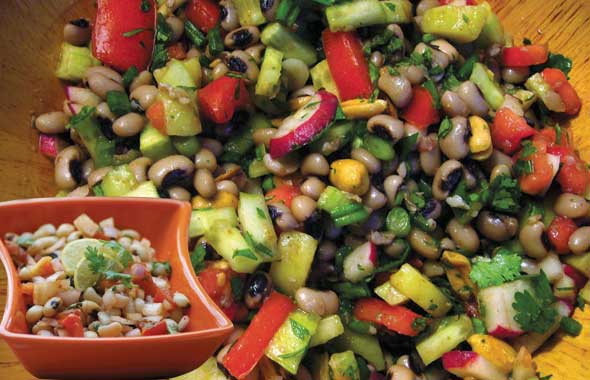Mama’s Punjabi Recipes: Lobia Di Chaat (Black Eyed Pea Snack)
There are several ways to make lobia (black eyed pea): in a curry, sautéed or served cold as a snack. Eaten in any way, lobia is a nourishing and satisfying vegetable that can be served with many other dishes. Their soft buttery taste and ease of cooking makes them a popular alternative to rajma (kidney beans) or even the favorite chole (chickpeas).
You can find the long strands of fresh young lobia (usually called rongi in Punjabi) in stores and many people just chop them up and cook them with potatoes. But you can also find fresh shelled lobia at the street vegetable hawker’s stall and these are best eaten in a chaat because they are still so tender. Most of us aren’t so lucky, especially overseas, so you have to do with dried lobia beans or the kind found in cans in the frozen food aisle.
In Indian cuisine, there are many types of chaats – most easily described as cold, spicy, mixed salad – that tantalize the taste buds in many ways. They are ubiquitous in hawker stalls all over India and are often eaten as a meal by itself because of the high amount of carbohydrate foods that are used and also because they are inexpensive. Chaats are often served with spicy chutnies and topped with lots of raw green garnishes like raw onions, cilantro and tomatoes.
Some chaats – like papadi chaat – require ingredients that take lots of preparation and use fried foods. Others, like lobia chaat, are much simpler, and faster to make. If you can’t find fresh lobia, use the frozen variety found in most grocery stores. For more taste, you can add a touch of hing (asafoetida), jeera (cumin) and garam masala.
Ingredients:
200 gm lobia (black eyed pea) if using frozen, medium bag, thawed
1 medium piyaaz (onion) – peeled and finely chopped
1 tsp lasan (garlic) – powdered
1 tbsp adrak (ginger)- powdered
2 tbsp imbli (tamarind) chutney
2 tbsp olive oil
Spices (to taste): namak (salt), mirch (red pepper), dhania (coriander), garam masal, amchoor (green mango powder)
Directions:
1. Wash the lobia well, then pour into a pot and let them soak overnight in warm water.
2. Pour them with the water in a pot and bring to a boil for 15 minutes. If you can find frozen black-eyed peas from the grocery store and use them instead, then skip this step.
3. When the beans are soft (but not mushy), drain the water through a strainer and pour the lobia into a medium sized mixing bowl.
4. Pour in the olive oil and stir to coat the beans. Now add in the onions, garlic, ginger and imbli and mix well, but try not to smash the beans. Add in the rest of the spices and stir in well.
5. Place in the fridge for 30 minutes to chill. Before serving, sprinkle with garam masala.
MAMA’S TIP OF THE WEEK
USE THE LAST SMALL PIECES OF BATH SOAP FOR CLEANING HOUSE
We all face the annoying problem of what to do with the last pieces of bath soap. They are much too small to use handily and yet you don’t feel like throwing them away. These last slithers wear down so much that even using them to wash hands can be difficult. Yet, you may feel that throwing them away is being wasteful.
The same thing could be said of the one sock that remains after the other one of the pair is gone. Sometimes, the washer-dryer has eaten one up and you just can’t find the other! You may feel it’s a shame to throw away a completely good sock.
Well, I joined the two items together and now throw all the small pieces of hand and bath soap in the remaining sock. Just bundle up the loose end, wet it down and use the soap-sock to clean up the sink and other household surfaces. It suds up well and also scrubs gently. When the soap is finished, you can throw the sock away: a completely biodegradable solution!!
Shakuntla Malhotra is a skilled cook of Punjabi dishes made in the old-fashioned style that she learnt as a young woman in her ancestral home in Lyallpur (since renamed Faisalabad), India before it became part of Pakistan after the Partition in 1947. People have often admired her cooking for its simplicity and taste that comes with each mouthful. Even in her mid-eighties, she continues to cook daily and agreed to share some of her delectable Punjabi recipes.


